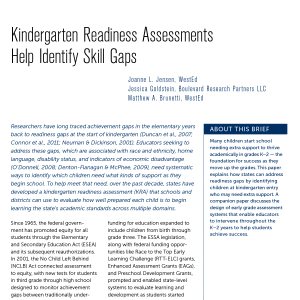Early Grade Assessments to Support Student Readiness and Success: Interview with WestEd's Joanne Jensen
Posted on by Joanne Jensen

Many children start school needing extra support to thrive academically in grades K–2, the foundation for success as they move up through elementary and high school.
Two recent policy briefs written by WestEd’s Joanne Jensen, Jessica Goldstein, and Matthew Brunetti explain how states can bridge readiness gaps by identifying children at kindergarten entry who may need extra support and discuss the design of early grade assessment systems that enable educators to intervene throughout the K–2 years to help students achieve success.
 Joanne Jensen, Director of Assessment Design and Development at WestEd, develops strategic solutions to address state and district assessment needs, and she serves as a senior technical advisor for WestEd’s assessment development contracts. She discusses the importance of early grade assessments in this Q&A.
Joanne Jensen, Director of Assessment Design and Development at WestEd, develops strategic solutions to address state and district assessment needs, and she serves as a senior technical advisor for WestEd’s assessment development contracts. She discusses the importance of early grade assessments in this Q&A.
Q: How does kindergarten entry data have the potential to serve as a tool for equity?
Children enter kindergarten with different early learning and school experiences and with widely varying levels of proficiency in the knowledge and skills that are foundational to later learning. Kindergarten entry assessments, or KRAs, provide educators with data to help identify students who may not have mastered these essential foundational skills and to ensure they receive the necessary instruction and supports as they enter kindergarten.
Q: How are states using KRA data for multiple purposes?
KRAs can be used to provide a profile of students’ skills at kindergarten entry to help schools identify students who may benefit from additional monitoring or targeted interventions and supports. Performance on the KRA can serve as an early warning, but the assessment results need to be associated with effective interventions in order to impact student learning.
KRA data can also serve as the first data point to track longitudinal performance across grade levels based on a common assessment administered statewide. Coupled with subgroup analyses, it is possible to track the effectiveness of instruction as measured by standards-aligned assessments and to determine whether all students are making gains or whether there are groups of students who are not making progress toward grade-level expectations.
The trends from KRA data can help inform policy, programmatic, and funding decisions. Many states support preschool programs. Are those programs truly helping to prepare students for kindergarten? Are there specific programs that are having more positive outcomes? What are the characteristics of the effective programs that could inform policy and practice in programs that are not having similar outcomes?
While the answers to these questions can prove essential to instructional planning, it’s important to remember that the assessments should be viewed as just one data point to help inform how well students are achieving against grade-level expectations. All assessment data must be considered in conjunction with other critical information, such as feedback from teachers, parents, and the students themselves.
Q: As you mention in the companion paper, there is no systematic state-level attempt to evaluate students’ ongoing progress in grades K–2, the grades that lay the foundation for all later learning. Why hasn’t K–2 assessment been a priority for states? How can this lag be addressed?
With the passage of the No Child Left Behind Act, states were required to test students in both reading and mathematics in grades 3–8 and at least once in high school. Until then, most states tested at only select grades. There is no similar federal mandate that requires testing of students in K–2. Developing and maintaining a statewide assessment system requires significant dollars, and without federal support many states have not made the investment in K–2.
We know the impact on students of not being able to read. The lack of statewide assessments in K–2 grades represents a lost opportunity to monitor student learning against state standards by using a common assessment for all students. Again, the goal is to identify students whose performance is not meeting grade-level expectations as early as possible so that they can receive the needed supports. The costs for not doing so are great to both the individual student and society as a whole. As we note in our paper, without targeted instruction and interventions, students who are struggling at kindergarten entry frequently are still lagging behind many of their peers academically by the time they reach grade 3.
Q: How can states support K–2 assessment systems that are coherent and effective?
The key to building a coherent system is to be clear about the purpose of the assessment, what information you want to know about students, and how that information will be used. These are key elements of the important conversations that need to be held with policymakers at the state level to be sure there are common goals for the system.
As you can tell, I am a firm believer in a quality summative assessment, but having such information collected only once a year has its limits. This is where interim assessments can serve as a valuable adjunct to provide teachers with information about student performance at key periods throughout the school year and to allow for remediation as needed. Many schools and districts administer their own interim assessments, but the alignment of those assessments to a state’s standards and expectations can differ. Having a state provide an interim assessment system that aligns with the expectations of that state provides built-in coherency within the system. Alternatively, states can achieve coherence by evaluating and endorsing assessments that show alignment with both the content standards and performance expectations. This type of alignment is critical to the delivery of a consistent message about student performance.
Screener assessments administered at key points through the early grades also are an option for identifying students who are in need of intervention. Screeners are typically shorter in length and are targeted to specific content, so they have the advantage of taking less time to administer. However, they also lack the breadth of content coverage afforded by interim assessments.
Q: The brief describes the different types of assessments and their benefits and limitations, but you say formative assessment practices enrich the utility of each individual assessment tool. Why is that?
Typically, summative assessments are given at the end of the school year, and interim assessments and screeners are administered at key times in the school year. Consequently, the time between instruction on specific content and these assessments could be weeks to months. In contrast, formative process continually actively engages teachers and students in definitions of learning and what the outcomes for learning look like. Effective formative assessment involves the teacher having clear learning goals and criteria for learning and then communicating that to students. Implementing this process ensures that teachers and students share a common understanding of what mastery looks like. The use of ongoing formative assessments provides evidence of students’ mastery of content in real instructional time, allowing for reteaching to optimize learning before moving onto new content. That is the true value of formative assessment.
Q: There are those who criticize early childhood assessment as a time-consuming practice that does not support learning. How would you respond to that?
As students enter kindergarten, having a teacher spend one-on-one time with each student to assess them on the critical skills necessary for success in school provides that teacher with actionable information for each child. And classroom data from these assessments can inform instruction by providing a snapshot of the knowledge and skills of the class as a whole.
The COVID-19 pandemic has shown us that students can interact effectively with technology, and there have been great strides in the computer delivery of assessments for students at younger ages. Students should still be monitored, but the ability to assess students online has reduced the testing burden for teachers and can provide timely results.
The Center for Standards, Assessment, and Accountability (CSAA) at WestEd supports educators in the development and use of rigorous standards and student-focused assessment and accountability practices. Our work impacts students of all ages and learning paths, including early childhood, K–12, postsecondary, and career technical education.

